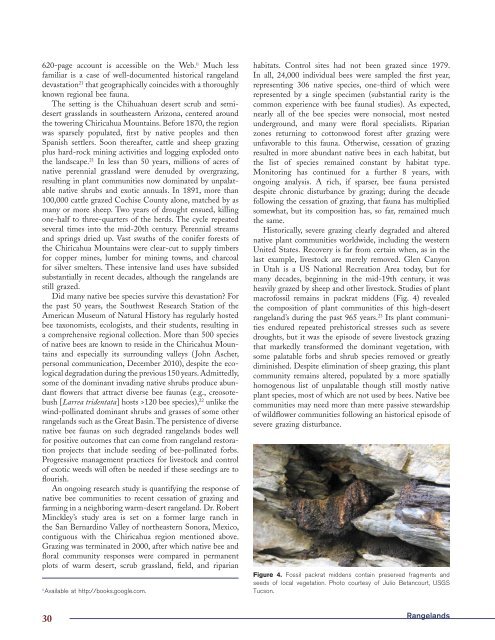Rangeland Magazine: Special Issue on Pollinators - The Xerces ...
Rangeland Magazine: Special Issue on Pollinators - The Xerces ...
Rangeland Magazine: Special Issue on Pollinators - The Xerces ...
You also want an ePaper? Increase the reach of your titles
YUMPU automatically turns print PDFs into web optimized ePapers that Google loves.
620-page account is accessible <strong>on</strong> the Web. ii Much less<br />
familiar is a case of well-documented historical rangeland<br />
devastati<strong>on</strong> 21 that geographically coincides with a thoroughly<br />
known regi<strong>on</strong>al bee fauna.<br />
<strong>The</strong> setting is the Chihuahuan desert scrub and semidesert<br />
grasslands in southeastern Ariz<strong>on</strong>a, centered around<br />
the towering Chiricahua Mountains. Before 1870, the regi<strong>on</strong><br />
was sparsely populated, first by native peoples and then<br />
Spanish settlers. So<strong>on</strong> thereafter, cattle and sheep grazing<br />
plus hard-rock mining activities and logging exploded <strong>on</strong>to<br />
the landscape. 21 In less than 50 years, milli<strong>on</strong>s of acres of<br />
native perennial grassland were denuded by overgrazing,<br />
resulting in plant communities now dominated by unpalatable<br />
native shrubs and exotic annuals. In 1891, more than<br />
100,000 cattle grazed Cochise County al<strong>on</strong>e, matched by as<br />
many or more sheep. Two years of drought ensued, killing<br />
<strong>on</strong>e-half to three-quarters of the herds. <strong>The</strong> cycle repeated<br />
several times into the mid-20th century. Perennial streams<br />
and springs dried up. Vast swaths of the c<strong>on</strong>ifer forests of<br />
the Chiricahua Mountains were clear-cut to supply timbers<br />
for copper mines, lumber for mining towns, and charcoal<br />
for silver smelters. <strong>The</strong>se intensive land uses have subsided<br />
substantially in recent decades, although the rangelands are<br />
still grazed.<br />
Did many native bee species survive this devastati<strong>on</strong>? For<br />
the past 50 years, the Southwest Research Stati<strong>on</strong> of the<br />
American Museum of Natural History has regularly hosted<br />
bee tax<strong>on</strong>omists, ecologists, and their students, resulting in<br />
a comprehensive regi<strong>on</strong>al collecti<strong>on</strong>. More than 500 species<br />
of native bees are known to reside in the Chiricahua Mountains<br />
and especially its surrounding valleys ( John Ascher,<br />
pers<strong>on</strong>al communicati<strong>on</strong>, December 2010), despite the ecological<br />
degradati<strong>on</strong> during the previous 150 years. Admittedly,<br />
some of the dominant invading native shrubs produce abundant<br />
flowers that attract diverse bee faunas (e.g., creosotebush<br />
[Larrea tridentata] hosts >120 bee species), 22 unlike the<br />
wind-pollinated dominant shrubs and grasses of some other<br />
rangelands such as the Great Basin. <strong>The</strong> persistence of diverse<br />
native bee faunas <strong>on</strong> such degraded rangelands bodes well<br />
for positive outcomes that can come from rangeland restorati<strong>on</strong><br />
projects that include seeding of bee-pollinated forbs.<br />
Progressive management practices for livestock and c<strong>on</strong>trol<br />
of exotic weeds will often be needed if these seedings are to<br />
flourish.<br />
An <strong>on</strong>going research study is quantifying the resp<strong>on</strong>se of<br />
native bee communities to recent cessati<strong>on</strong> of grazing and<br />
farming in a neighboring warm-desert rangeland. Dr. Robert<br />
Minckley’s study area is set <strong>on</strong> a former large ranch in<br />
the San Bernardino Valley of northeastern S<strong>on</strong>ora, Mexico,<br />
c<strong>on</strong>tiguous with the Chiricahua regi<strong>on</strong> menti<strong>on</strong>ed above.<br />
Grazing was terminated in 2000, after which native bee and<br />
floral community resp<strong>on</strong>ses were compared in permanent<br />
plots of warm desert, scrub grassland, field, and riparian<br />
ii<br />
Available at http://books.google.com.<br />
habitats. C<strong>on</strong>trol sites had not been grazed since 1979.<br />
In all, 24,000 individual bees were sampled the first year,<br />
representing 306 native species, <strong>on</strong>e-third of which were<br />
represented by a single specimen (substantial rarity is the<br />
comm<strong>on</strong> experience with bee faunal studies). As expected,<br />
nearly all of the bee species were n<strong>on</strong>social, most nested<br />
underground, and many were floral specialists. Riparian<br />
z<strong>on</strong>es returning to cott<strong>on</strong>wood forest after grazing were<br />
unfavorable to this fauna. Otherwise, cessati<strong>on</strong> of grazing<br />
resulted in more abundant native bees in each habitat, but<br />
the list of species remained c<strong>on</strong>stant by habitat type.<br />
M<strong>on</strong>itoring has c<strong>on</strong>tinued for a further 8 years, with<br />
<strong>on</strong>going analysis. A rich, if sparser, bee fauna persisted<br />
despite chr<strong>on</strong>ic disturbance by grazing; during the decade<br />
following the cessati<strong>on</strong> of grazing, that fauna has multiplied<br />
somewhat, but its compositi<strong>on</strong> has, so far, remained much<br />
the same.<br />
Historically, severe grazing clearly degraded and altered<br />
native plant communities worldwide, including the western<br />
United States. Recovery is far from certain when, as in the<br />
last example, livestock are merely removed. Glen Cany<strong>on</strong><br />
in Utah is a US Nati<strong>on</strong>al Recreati<strong>on</strong> Area today, but for<br />
many decades, beginning in the mid-19th century, it was<br />
heavily grazed by sheep and other livestock. Studies of plant<br />
macrofossil remains in packrat middens (Fig. 4) revealed<br />
the compositi<strong>on</strong> of plant communities of this high-desert<br />
rangeland’s during the past 965 years. 23 Its plant communities<br />
endured repeated prehistorical stresses such as severe<br />
droughts, but it was the episode of severe livestock grazing<br />
that markedly transformed the dominant vegetati<strong>on</strong>, with<br />
some palatable forbs and shrub species removed or greatly<br />
diminished. Despite eliminati<strong>on</strong> of sheep grazing, this plant<br />
community remains altered, populated by a more spatially<br />
homogenous list of unpalatable though still mostly native<br />
plant species, most of which are not used by bees. Native bee<br />
communities may need more than mere passive stewardship<br />
of wildflower communities following an historical episode of<br />
severe grazing disturbance.<br />
Figure 4. Fossil packrat middens c<strong>on</strong>tain preserved fragments and<br />
seeds of local vegetati<strong>on</strong>. Photo courtesy of Julio Betancourt, USGS<br />
Tucs<strong>on</strong>.<br />
30<br />
<str<strong>on</strong>g>Rangeland</str<strong>on</strong>g>s
















